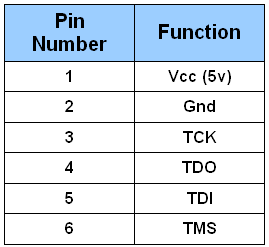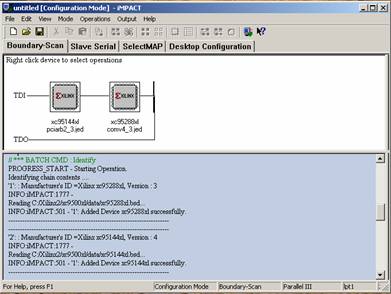
Carrier board CPLD update required
The SMT310Q' series carrier board are populated with two Xilinx CPLDs (XC95144XL and XC95288XL) that act as an on-board arbitration unit that control which device has access to the Local Bus resources. These devices are very important on the carrier board, and it is necessary to keep these devices up-to-date.
From time to time, Sundance might issue a CPLD update. The Sundance wizard will alert you when you need to update your CPLD. You have one of two choices.
Contact Sundance, and arrange for the CPLD update to be performed.
Perform the update yourself.
To update the firmware, Xilinx JTAG programming software is required together with a lead to connect to the SMT310Q header. The image below shows the location of the pin number 1 of the JTAG connector J21. This is a (2x3) 2mm pin header:

The following table shows the location of the JTAG signals on the header:

There are 4 things that you require to update the CPLDs on a SMT310Q:
The Xilinx IMPACT tool. If you do not have IMPACT, you need to download the software package from Xilinx called Xilinx Webpack. It is free and it includes the Xilinx IMPACT tool that will allow you to reprogram the CPLDs on the SMT310Q carrier board.
The JTAG programming cable named the Xilinx Parallel Cable IV (from Xilinx)
The adaptor to connect the Parallel Cable IV to the header J21 of the SMT310Q as shown in the table above.
The files needed for the update can be downloaded here.
To access the CPLDs you need both the Xilinx Parallel Programming cable IV, and the Xilinx ISE version 6.3 or later.
Note: The earlier versions of IMPACT do not support the type of CPLDs on-board the SMT310Q.
The CPLDs can be accessed through the JTAG connector J21:

After the JTAG cable has been connected the user should run the IMPACT tool. Once the connection has been detected and setup IMPACT will show that there are two different CPLDs:

The CPLD code that you have downloaded is included in the package you download from Sundance. You can check the CPLD versions in the file ReadMe.txt that accompany this package.
The first CPLD (XC95144XL) in the JTAG chain needs to be loaded with the file named "pciarb.jed". For the second CPLD (XC95288XL) the user will want to load the file "comm.jed".
Important:
After the CPLDs have been programmed, you have to run the SetCpld.exe utility contained in the package. This utility is run from a command line, and will change the CPLD version number stored on the carrier board. This version information is used by the Sundance wizard and other Sundance software to know the features of the carrier board.
At this point you should reboot the PC and run the SMTBoardInfo utility tool (SMT6300). Place a Sundance DSP module on the first TIM site of the carrier board and run the confidence test, which is part of SMTBoardInfo program. If this test passes, the CPLDs update has been successful.
If you do encounter any difficulties, please report them to the Sundance Support Team via the Support Forum.